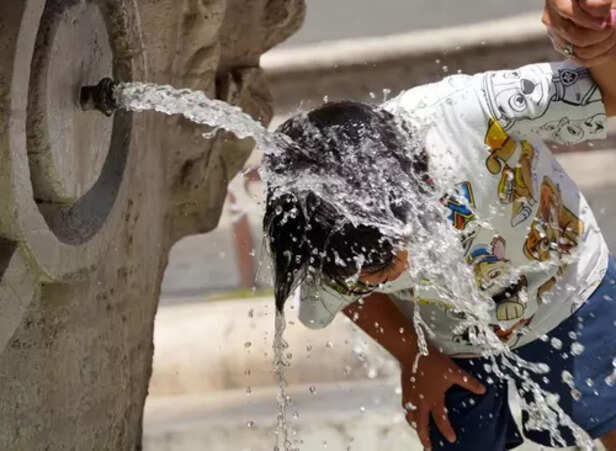From Heatstroke to Hydration: Guide to Surviving Extreme Heat
Amritansh Nayak | Apr 18, 2025, 16:25 IST

( Image credit : IANS )
In addition to discussing health dangers, cost-effective cooling techniques, hydration and nutrition advice, smart clothing selections, and emergency solutions to heat-related illnesses, this article provides helpful advice for surviving high heat. In order to stay safe and comfortable during heatwaves without significantly relying on air conditioning, it places an emphasis on prevention, awareness, and easy lifestyle changes.
Extreme heat has becoming a more frequent and hazardous problem for people worldwide as global temperatures continue to climb. Heatwaves are becoming frequent hazards to people's comfort, safety, and health rather than isolated incidents. The impacts of high temperatures can range from slight discomfort to potentially fatal disorders like heatstroke, particularly for vulnerable groups including children, the elderly, and outdoor workers. The good news is that there are easy and affordable solutions to shield your loved ones and yourself from the risks associated with excessive heat. Practical tips for being safe and comfortable in hot weather are examined in this article.

Climate warming is making extreme heat more frequent and hazardous, with heatwaves posing major health risks to people. The body finds it difficult to control its internal temperature when temperatures rise. Dehydration, heat exhaustion, and in extreme situations, heatstroke—a potentially fatal illness in which the body overheats quickly and becomes incapable of cooling itself—can result from this. If treatment is delayed, symptoms may include nausea, fast heartbeat, confusion, and even unconsciousness.
Extreme heat poses a special risk to some groups. Elderly people are more vulnerable since they may not notice temperature changes as well and may have underlying medical issues. Children are more vulnerable due to their developing systems and lesser body mass. Due to their extended exposure to the sun and physical strain, outdoor workers—such as those in construction and agriculture—are more vulnerable to heat-related ailments. Preventing catastrophes requires an understanding of who is most at risk and how heat impacts the body. Extreme heat occurrences can be lessened via community cooperation, early warning systems, and public awareness. Not only is it wise to take precautions, but doing so could save lives during the next heat wave.

It becomes more important to stay cool at home as summer temperatures rise, but doing so doesn't have to result in a large electrical cost. There are several low-cost strategies to keep your house pleasant while combating the heat. Easy fixes, such as strategically placing fans, can make a big difference. While ceiling or standing fans enhance airflow throughout the house, placing fans near windows during the colder hours of the day can assist pull in fresh air. During the hottest hours, keep your blinds or drapes closed to keep out direct sunlight and lower the temperature inside. A natural breeze can also be produced to cool the house by opening windows on different sides, a technique known as cross-ventilation.
You can also try some ingenious do-it-yourself tricks. Before going to bed, place ice packs or bottles of cold water beneath your pillow. You can even make your own air cooler by setting a bowl of ice in front of a fan. Frozen washcloths and bedding made of light cotton can also help. You may maintain your comfort and coolness without depending entirely on air conditioning by employing these inexpensive tips. When the heat is on, little adjustments can have a significant impact.

Your body has to work harder to keep cool when the temperature rises, usually via perspiring, which causes fluid and vital electrolyte loss. Because of this, maintaining adequate hydration is one of the most crucial methods to stay safe in intense heat. Drinking water should be your first choice, but don't undervalue the benefits of rehydrating with electrolyte drinks, coconut water, or even homemade solutions with a little sugar and salt. Another important factor is nutrition. It's recommended to choose light, hydrating meals like salads, fruits, yogurt, and soups on hot days.
Cucumbers, melons, and oranges are examples of foods high in water that naturally increase fluid consumption while keeping your body cool. Meals that are smaller and more frequent are easier to digest and keep your body from producing excess heat. However, it's crucial to stay away from items that can cause dehydration or upset your digestive tract. Caffeine-rich beverages, heavy, oily meals, and excessively salty snacks can all interfere with your body's ability to regulate its temperature. When the heat is at its worst, careful diet and smart hydration are effective strategies to keep you safe and energized.

What you wear and how you plan your day can have a significant impact on your safety and comfort when intense heat strikes. Wearing the appropriate clothes keeps your body cool and prevents overheating. The best clothing is light-colored, loose-fitting, and lightweight because these materials let air flow and reflect sunshine instead of absorbing it. Because they breathe better than synthetic ones, natural fabrics like linen and cotton work particularly well. Accessories are also important; breathable shoes, UV-blocking sunglasses, and wide-brimmed hats can all offer extra sun protection. When spending time outside, wear clothing that wicks away sweat and use high-SPF sunscreen.
It's equally crucial to strategically plan your day. When the weather is cooler, try to plan outdoor activities for the early morning or late evening. When the sun is at its strongest, between 11 a.m. and 4 p.m., stay away from physically demanding activities. Drink lots of water and take regular pauses in the shade if you must be outside during those hours.
You can significantly lower your risk of heat exhaustion and maintain more comfort throughout the day, even during a heatwave, by clothing appropriately and controlling your daily schedule.

If early warning signs are disregarded, extreme heat can swiftly turn into a medical disaster. It can save lives to know how to identify and treat heat-related disorders including heat exhaustion and heatstroke. The initial stage is frequently heat exhaustion, which manifests as chilly, clammy skin, headache, nausea, disorientation, and excessive perspiration. Heatstroke, a far more serious illness in which the body is unable to control its temperature, can develop if treatment is not received. A high body temperature (over 103°F or 39.4°C), dry or flushed skin, disorientation, a fast heartbeat, and even unconsciousness are all signs of heatstroke.
As soon as someone exhibits symptoms of heat exhaustion, take them to a cooler location, unclothe them, and offer them water. Using a fan or applying cool, damp towels might also be beneficial. Heatstroke is a potentially fatal illness, so get emergency medical attention right once. Use cold compresses or ice packs to try to cool the person's neck, armpits, and groin while you wait for assistance. During a heat-related emergency, being ready and responding promptly might make all the difference. Preventing these preventable yet dangerous health hazards requires public awareness, particularly during heatwaves.
Adapting to great heat is now necessary, not voluntary, as the earth continues to warm and heatwaves increase in frequency and intensity. The good news is that being safe and comfortable without excessively relying on air conditioning is completely achievable with awareness, preparedness, and a few wise lifestyle adjustments. You may safeguard yourself and others around you on even the warmest days by being aware of the risks of heat-related illnesses, implementing inexpensive home cooling techniques, drinking enough water, eating light, wholesome meals, wearing appropriately, and knowing what to do in an emergency. Although extreme heat is a growing hazard, it doesn't have to become a personal disaster if people are aware of it and take preventative measures.
Explore the latest trends and tips in Health & Fitness, Travel, Life Hacks, Fashion & Beauty, and Relationships at Times Life!

heat exhaustion safety
( Image credit : IANS )
Recognizing the Dangers of Extreme Heat
Extreme heat poses a special risk to some groups. Elderly people are more vulnerable since they may not notice temperature changes as well and may have underlying medical issues. Children are more vulnerable due to their developing systems and lesser body mass. Due to their extended exposure to the sun and physical strain, outdoor workers—such as those in construction and agriculture—are more vulnerable to heat-related ailments. Preventing catastrophes requires an understanding of who is most at risk and how heat impacts the body. Extreme heat occurrences can be lessened via community cooperation, early warning systems, and public awareness. Not only is it wise to take precautions, but doing so could save lives during the next heat wave.

stay hydrated in summers
How to Keep Cool at Home Without Going Over Budget
You can also try some ingenious do-it-yourself tricks. Before going to bed, place ice packs or bottles of cold water beneath your pillow. You can even make your own air cooler by setting a bowl of ice in front of a fan. Frozen washcloths and bedding made of light cotton can also help. You may maintain your comfort and coolness without depending entirely on air conditioning by employing these inexpensive tips. When the heat is on, little adjustments can have a significant impact.

summers and hydration
Food and Hydration on Hot Days
Cucumbers, melons, and oranges are examples of foods high in water that naturally increase fluid consumption while keeping your body cool. Meals that are smaller and more frequent are easier to digest and keep your body from producing excess heat. However, it's crucial to stay away from items that can cause dehydration or upset your digestive tract. Caffeine-rich beverages, heavy, oily meals, and excessively salty snacks can all interfere with your body's ability to regulate its temperature. When the heat is at its worst, careful diet and smart hydration are effective strategies to keep you safe and energized.

clothing for summers
How to Arrange Your Day and What to Wear
It's equally crucial to strategically plan your day. When the weather is cooler, try to plan outdoor activities for the early morning or late evening. When the sun is at its strongest, between 11 a.m. and 4 p.m., stay away from physically demanding activities. Drink lots of water and take regular pauses in the shade if you must be outside during those hours.
You can significantly lower your risk of heat exhaustion and maintain more comfort throughout the day, even during a heatwave, by clothing appropriately and controlling your daily schedule.

dangers of heat waves
Identifying Heat Illness and Providing Emergency Advice
As soon as someone exhibits symptoms of heat exhaustion, take them to a cooler location, unclothe them, and offer them water. Using a fan or applying cool, damp towels might also be beneficial. Heatstroke is a potentially fatal illness, so get emergency medical attention right once. Use cold compresses or ice packs to try to cool the person's neck, armpits, and groin while you wait for assistance. During a heat-related emergency, being ready and responding promptly might make all the difference. Preventing these preventable yet dangerous health hazards requires public awareness, particularly during heatwaves.
Adapting to great heat is now necessary, not voluntary, as the earth continues to warm and heatwaves increase in frequency and intensity. The good news is that being safe and comfortable without excessively relying on air conditioning is completely achievable with awareness, preparedness, and a few wise lifestyle adjustments. You may safeguard yourself and others around you on even the warmest days by being aware of the risks of heat-related illnesses, implementing inexpensive home cooling techniques, drinking enough water, eating light, wholesome meals, wearing appropriately, and knowing what to do in an emergency. Although extreme heat is a growing hazard, it doesn't have to become a personal disaster if people are aware of it and take preventative measures.
Explore the latest trends and tips in Health & Fitness, Travel, Life Hacks, Fashion & Beauty, and Relationships at Times Life!
